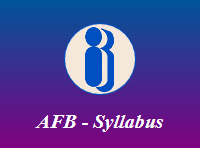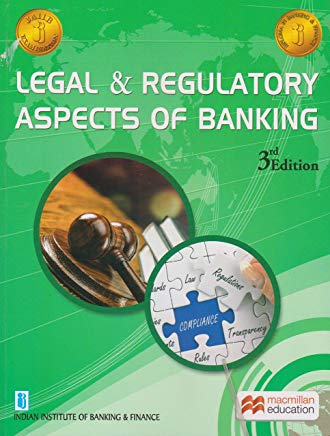JAIIB Accounting & Finance for Bankers (AFB) Module wise Syllabus

Are you searching for the syllabus of JAIIB Accounting & Finance for Bankers (AFB) exam? Here at "Jaiib Mock Test", we have complete syllabus of JAIIB Exam (Paper 2) which is also known as JAIIB AFB examination. The Indian Institute of Banking & Finance (IIBF) will conduct - JAIIB "Accounting & Finance for Bankers" exam. So for the better preparation of this exam we are proving you very important JAIIB (AFB) course material:
| Mock Test | JAIIB AFB - Practice Free Online Mock Test Paper |
| Book | JAIIB AFB - Workbook (Official Study Guide) |
| Short Notes | JAIIB AFB - Important Short Study Notes |
PDF Syllabus for JAIIB Paper 2 (AFB) Exam
We are providing you the complete JAIIB AFB syllabus in a very clear format so that you can read it online. But if you wish to read it in PDF format then you can easily download the PDF syllabus of JAIIB "Accounting & Finance for Bankers (AFB) exam from the official website of The Indian Institute of Banking & Finance (IIBF).
There are 5 modules in the syllabus of JAIIB Accounting & Finance for Bankers (AFB) exam as mentioned below:
JAIIB AFB Module (A) Syllabus: Business Mathematics and Finance
Recommended: JAIIB AFB Module A Study Notes
| Name of the Unit in the module | Contents |
|---|---|
| Calculation of Interest and Annuities | Calculation of Simple Interest & Compound Interest; Calculation of Equated Monthly Instalments; Fixed and Floating Interest Rates; Calculation of Annuities; Interest Calculation using Products/Balances; Amortisation of a Debt; Sinking Funds |
| Calculation of YTM | Debt- Definition, Meaning & Salient Features; Loans; Introduction to Bonds; Terms associated with Bonds; Cost of Debt Capital; Bond value with semi-annual Interest; Current Yield on Bond; Calculation of Yield-to-Maturity of Bond; Theorems for Bond Value; Duration of Bond; Properties of Duration; Bond Price Volatility |
| Capital Budgeting | Present Value and Discounting; Discounted Technique for Investment Appraisal; Internal Rateof Return (IRR); Method of Investment Appraisal; NPV and IRR compared; Investment Opportunities with Capital Rationing; Investment Decision making under condition of uncertainty; Expected NPV Rule; Risk Adjusted Discount Rate Approach for NPV Determination; Sensitivity Analysis for NPV Determination; Decision Tree Analysis for NPV Estimation; Payback Methods; ARR. |
| Depreciation and its Accounting | Depreciation, its types and methods; Comparing Depreciation Methods |
| Foreign Exchange Arithmetic | Fundamentals of Foreign Exchange; Forex Markets; Direct and Indirect Quote; Some Basic Exchange Rate Arithmetic – Cross Rate, Chain Rule, Value date, etc.; Forward Exchange Rates – Forward Points; Arbitrage; Calculating Forward Points; Premium/discount; etc. |
JAIIB AFB Module (B) Syllabus: Principles of Bookkeeping & Accountancy
Recommended: JAIIB AFB Module B Study Notes
| Name of the Unit in the module | Contents |
|---|---|
| Definition, Scope and Accounting Standards | Nature and Purpose of Accounting; Historical Perspectives; Origins of Accounting Principles; Accounting Standards in India and its Definition and Scope; Generally Accepted Accounting Principles of USA (US GAAP); Transfer Pricing; Overview of IFRS; Difference between GAAP &IFRS. |
| Basic Accountancy Procedures | Concepts of Accountancy; Entity Going Concern Entity; Double Entry System; Principle of Conservatism; Revenue Recognition and Realisation; Accrual and Cash Basis. |
| Maintenance of Cash/ Subsidiary Books And Ledger | Record Keeping Basics; Account Categories; Debit and Credit Concepts; Accounting and Columnar Accounting Mechanics; Journals; Ledgers; subsidiary books; etc. |
| Bank Reconciliation Statement | Need for Bank Reconciliation; Causes of Differences; Preparation of Bank Reconciliation Statement; How to prepare a Bank Reconciliation Statement when Extracts of Cash Book and PassBook are given; Adjusting the Cash Book Balance; Advantages of Bank Reconciliation Statement. |
| Trial Balance, Rectification of Errors and Adjusting & Closing Entries | Meaning of a Trial Balance; Features and Purpose of a Trial Balance; Types of Trial Balance and Preparation of a Trial Balance; Disagreement of a Trial Balance; Classification ofErrors; Location of Errors; Rectification of Errors; Suspense Account and Rectification; Rectification of Errors when Books are closed; Adjusting and Closing Entries. |
| Capital and Revenue Expenditure | Expenditure; Distinction between Capital and Revenue Expenditure; Deferred Revenue Expenditure; Receipts; General Illustrations. |
| Bills of Exchange | Types of Instruments of Credit; Term and Due Date of a Bill; Certain Important Terms; Accounting Entries to be Passed; Accommodation Bill etc. |
JAIIB AFB Module (C) Syllabus: Final Accounts
Recommended: JAIIB AFB Module C Study Notes
| Name of the Unit in the module | Contents |
|---|---|
| Balance Sheet Equation | Balance Sheet Equation; Computation of Balance Sheet Equation. |
| Preparation of Final Accounts | Preparation of Trading A/C; Profit and Loss A/C; Profit & Loss Appropriation Account; Balance Sheets |
| Ratio Analysis | Meaning of Accounting Ratios; Classification of Ratios; Uses of Accounting Ratios; Limitations of Accounting Ratios; Calculation and interpretation of various Ratios; Different Users and their Use of Ratios. |
| Final Accounts of Banking Companies | Definition and Functions of a Bank; Requirements of Banking Companies as to Accounts and Audit; Significant Features of Accounting Systems of Banks; Principal Books of Accounts; Preparation and Presentation of Financial Statements of Banks; CMA Format; Accounting Treatment of Specific Items; Preparation of Profit and Loss Account; Comments on Profit and Loss Account; Important Items of Balance Sheet; Disclosure Requirements of Banks; Additional Disclosures prescribed by RBI; Disclosures required under BASEL norms. |
| Company Accounts I & II | Definition and Types of Companies; Distinction between Partnership and Limited Liability Company; Classes of Share Capital; Issue of Shares; General Illustrations Non-voting Shares; Form of Balance Sheet; Legal Requirements for Assets; Legal Requirements for Liabilities; Legal Requirements for Profit & Loss A/c; Preparation of Final Accounts |
| Accounting in a Computerized Environment | Meaning, Features of and Terms used in Computerized Accounting; Difference between Computerized and Manual Accounting; Advantages and Disadvantages of Computerized Accounting; Functions performed by Computerized Accounting Softwares available in the Market; Computerization – Scope and Experiences in Banking; The Core Banking Components; Information Security; Internet and World Wide Web – Influences on Banking |
JAIIB AFB Module (D) Syllabus: Banking Operations
Recommended: JAIIB AFB Module D Study Notes
| Name of the Unit in the module | Contents |
|---|---|
| Banking Operations & Accounting Functions | Preparation of Vouchers, cash receipt and payment entries, clearing inward and outward entries, transfer debit and credit entries, what is KYC and what are the different documents to satisfy KYC, verify KYC and authenticity of documents, operational aspects in regard too pening of all types of accounts, scrutiny of loan applications/documents, allowing drawals and accounting entries involved at various stages, operational aspects of CBS environment etc., Back office operations in banks, handling of unreconciled entries in banks. |


